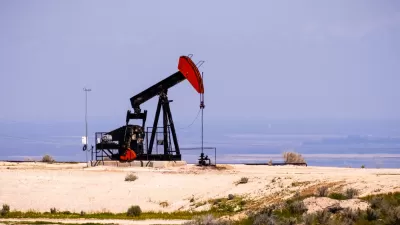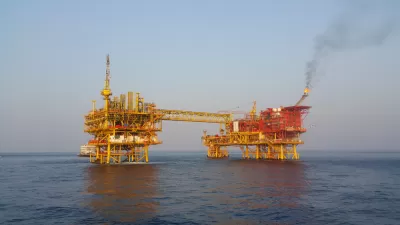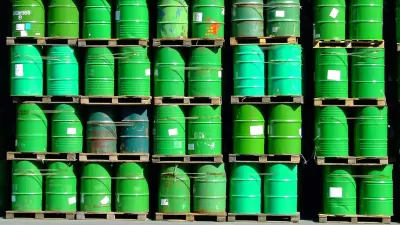The world's third cheapest gasoline will increase by 40 percent in order to deal with a record budget deficit of $98 billion this year. Plummeting oil prices have forced the world's largest oil exporter, Saudi Arabia, to reduce energy subsidies.
Major change is coming to Saudi Arabia. No, I'm not talking about allowing women to drive. This change will have beneficial environmental and economic consequences, though it remains to be seen how motorists will take it.
A world awash in cheap oil has been able to do what the International Monetary Fund (IMF) has unsuccessfully been advising them and other oil exporters to do for years: remove energy subsidies to reduce energy consumption and greenhouse gas emissions.
In a February post on reducing energy subsidies, it was noted that "Saudi Arabia, Russia and Venezuela — three of the most heavily subsidized countries — have done little or nothing to reform," wrote Clifford Krauss for The New York Times.
Income from oil "accounts for over 90 percent of public revenues" in Saudi Arabia according to Deutsche Welle (DW) News. So when oil prices fall, so does income to the national budget.
"The budget deficit has been the highest in the history of Saudi Arabia, which is currently the world's largest oil exporter," reports Agence France-Presse (AFP) via Press TV.
It was the second deficit year in a row for Saudi Arabia and Riyadh [capital city] is expected to announce another shortfall when it unveils its 2016 budget later on Monday [Dec. 28].
But the big news is not the size of Saudi Arabia's deficit. After all, in February, The Washington Post reported that it had $750 billion in cash reserves to deal with these deficits. It's the measures the Saudi leaders are resorting to deal reduced revenue.
Budgetary pressure is forcing Saudi Arabia to review the prices of heavily-subsidized electricity and fuel in the country in what has been seen as part of Riyadh’s new measures to cope with low oil prices.
Saudi Arabia’s official Saudi Press Agency on Monday reported that Riyadh has decided to raise gasoline prices by more than 50 percent for some products [on] Tuesday as it cuts a range of subsidies.
Prices will also increase for electricity, water, diesel and kerosene under the cuts approved by the council of ministers, which is headed by Saudi Arabia’s King Salman.
Al Jazeera reports that the policy change would result in a 40 percent in gas prices at the pump.
In order to address the situation, the Gulf kingdom has set the price of 95 octane gasoline at 0.90 riyals ($0.24) per litre up from 0.60 riyals per litre - a hike of 40 percent. The price increase takes effect on Tuesday, the official SPA news agency said on its Twitter account.
A price of $.24 per liter equals $.908 a gallon. Gas prices on Dec. 21, according to GlobalPetrolPrices.com, were $.15 per liter, the third lowest in the world after Venezuela and Libya.
Returning to the size of the budget deficit announced by SPA on Monday, Russia's news agency, Sputnik, took a swipe at their chief oil export competitor, one they no doubt blame for the fall in prices stemming from an OPEC meeting last year in a Nov. 21 article, "Oil Reliance Policy Dragging Saudi Arabia to the Brink of Economic Collapse."
While Sputnik failed to mention the contraction in the Russian economy due to low oil prices, it did note a recent IMF report calling on Saudi Arabia to diversify its economy to become less oil dependent. However, as noted above, the IMF has also called on Russia to reduce its energy subsidies, which Saudi Arabia has now chosen to do. Will Russia follow, or, for that matter, the U.S?
FULL STORY: Saudi posts record $98 bn deficit in 2015

Planetizen Federal Action Tracker
A weekly monitor of how Trump’s orders and actions are impacting planners and planning in America.

Congressman Proposes Bill to Rename DC Metro “Trump Train”
The Make Autorail Great Again Act would withhold federal funding to the system until the Washington Metropolitan Area Transit Authority (WMATA), rebrands as the Washington Metropolitan Authority for Greater Access (WMAGA).

DARTSpace Platform Streamlines Dallas TOD Application Process
The Dallas transit agency hopes a shorter permitting timeline will boost transit-oriented development around rail stations.

Supreme Court Ruling in Pipeline Case Guts Federal Environmental Law
The decision limits the scope of a federal law that mandates extensive environmental impact reviews of energy, infrastructure, and transportation projects.

Texas State Bills to Defund Dallas Transit Die
DART would have seen a 30% service cut, $230M annual losses had the bills survived.

Bikeshare for the Win: Team Pedals to London Cricket Match, Beats Rivals Stuck in Traffic
While their opponents sat in gridlock, England's national cricket team hopped Lime bikes, riding to a 3-0 victory.
Urban Design for Planners 1: Software Tools
This six-course series explores essential urban design concepts using open source software and equips planners with the tools they need to participate fully in the urban design process.
Planning for Universal Design
Learn the tools for implementing Universal Design in planning regulations.
Roanoke Valley-Alleghany Regional Commission
City of Mt Shasta
City of Camden Redevelopment Agency
City of Astoria
Transportation Research & Education Center (TREC) at Portland State University
US High Speed Rail Association
City of Camden Redevelopment Agency
Municipality of Princeton (NJ)





























